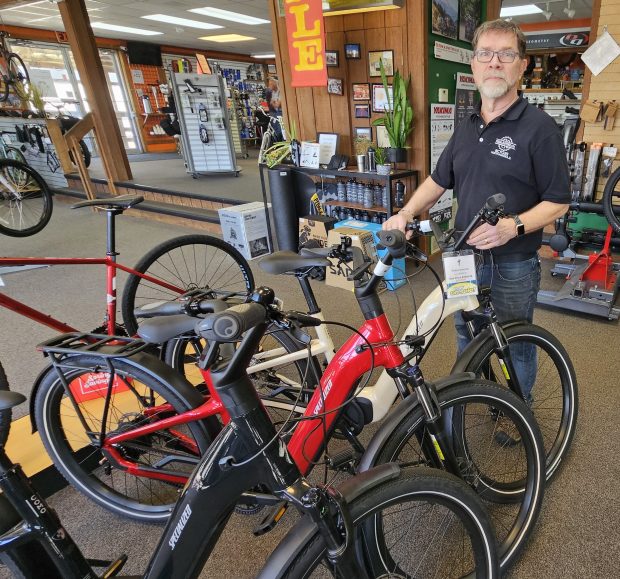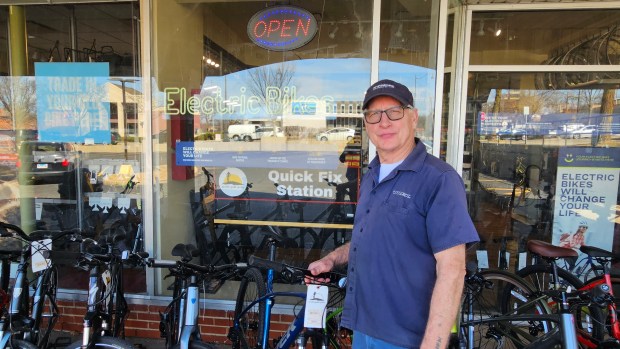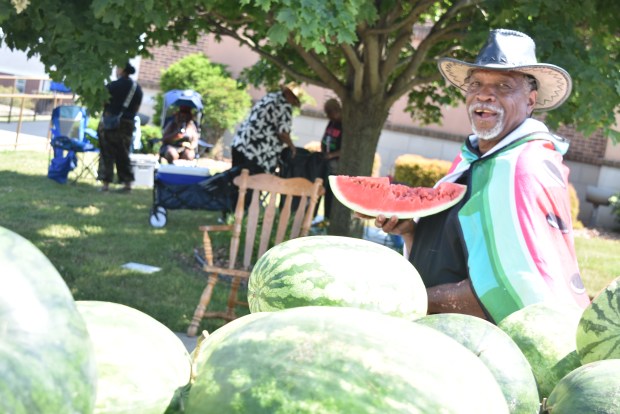While longtime fans still remain married to their traditional bicycles, the growing popularity of e-bikes is clearly the focus among many Aurora area bike shops as sales continue to grow thanks to better technology, improved batteries and more.
Bruce Heidlauf, who has operated the Mill Race Cyclery in Geneva for 42 years, said last year was perhaps the best he ever had, which included more than 50% of his sales in the e-bike category.
“We had a fantastic year last year and don’t see any reason why it wouldn’t continue,” Heidlauf said recently. “We’ve got our inventory all ready to go and all the bikes built. Last year was the best year we ever had – we were about 20% up for the year – and I attribute it to the growth in e-bike sales.”
Heidlauf’s shop was not alone. According to IMARC – a leading market research company “that offers management strategy and market research worldwide” – the United States e-bike market reached over $1 billion in sales in 2024.
The group notes that it expects the market to reach $2.5 billion in sales by 2033, a growth rate of 9.78%.
IMARC attributes increased sales to “ongoing advancements in e-bike technology resulting in improvements in battery life, motor efficiency and overall performance … making e-bikes more appealing and reliable to a broader consumer base, which is positively impacting the United States e-bike market outlook.”
Heidlauf agrees that e-bikes are continuing to evolve.
“Coming out of COVID, we saw about maybe 30% of sales in e-bikes and right now that’s where the growth of the industry is, it’s in e-bikes, and there are so many more affordable price points coming in,” Heidlauf said. “It’s been really strong for us, and we have about half a dozen lines of e-bikes that are working well for us.”
Growth in the product is tied, Heidlauf said, to there being more affordable options as well as an expansion of the demographic of e-bike users, something that Mike Brackett, owner of Pedal and Spoke in North Aurora for the past 49 years, is also seeing.
His e-bike sales were around 20% of his business a year ago and the trend this year “is a little bit up already” from that.
“I think people are maybe a little bit more comfortable with the economy, maybe they are used to spending the money or the product is more available,” Brackett said to explain the recent modest surge in e-bike sales.
Brackett said his customer demographic “is really expanding now,” noting that it used to be “retired couples or retired people just wanting to go out and have some fun.”
“Now, we’re seeing a more middle-aged group that are coming in to do it, and the kids that want to be on e-bikes,” he said. “We have a lot of customers that are ideal for e-bikes. They’re mismatched in abilities – one’s strong, one isn’t, or one has a health issue and the other doesn’t. For us, that’s ideal because they can get out and ride where they couldn’t before.”
Heidlauf said the demographic for e-bikes is expanding due to more awareness and a change in perspective.
“It’s gotten to be a lot more accepted. Originally, e-bikes were for an older crowd, but the age keeps coming down,” Heidlauf said. “I think it’s like friends go out on one and they’re having so much fun, and they get an e-bike. People see it’s something so many people are doing and it piques their interest. Years ago, people didn’t want to get an e-bike, they wanted to get exercise, but I kind of think people have gotten over that. Now they say I get as much exercise as I want on an e-bike – that’s up to me.”
Mike Farrell, owner of Prairie Path Cycles in Batavia, also reports that “in terms of dollars, our business is about 20% e-bikes” but adds that he’s happy traditional bike sales still lead the way by a landslide.
Those sales “as well as repairs on e-bikes” remain a healthy part of the business at Prairie Path Cycles, Farrell said.
“I’m happy to say the bulk of our sales remain regular bikes,” he said. “I want people to still appreciate regular bikes and there’s a place for e-bikes for sure, but I’d like to see it be more towards people that maybe wouldn’t ride at all or they’ve been riding their whole life and they want to keep riding the same distances they’re used to riding.”
Farrell said at his shop, e-bikes really began to establish themselves about five years ago, but that the technology has been in Europe for perhaps 20 years.
Heidlauf said in regards to technology, “batteries keep getting better” with battery life coming out the pandemic now 25% improved.
“They go 50 to 60 miles on a charge. Technology-wise, the electronics keep getting better and better,” Heidlauf said. “The bikes now have auto locks on them and all sorts of things they didn’t have before.
“All that kind of technology is now built into these bikes, and it’s really pretty cool,” he said.
Battery life has been extended, Brackett confirmed, giving a nod to the bikes’ initial market rollout overseas where “they’ve learned their ropes in Europe before they brought them to the states.”

“It does depend on the assist level that you use – with an ‘eco’ mode you can go much farther whereas ‘sport’ mode, you won’t go as far,” he said.
Farrell agrees there is increased battery life but adds that the power consumption is still controlled by the rider.
“I tell people you can be on an e-bike for four to five hours when you learn how to manage your energy draw, that’s the key,” he said. “I’ve personally been on an e-bike for four hours because of the amount of pedaling I do.”
Now is the time to buy any sort of bike, Farrell insists, “because everybody is blowing them out.”
“The prices, even on regular bikes, are way down because there is a glut on supply. Trek just lowered one of their $1,800 bikes down to $1,100, so that helps,” he said. “There are more entry level and mid-priced bikes.”
David Sharos is a freelance reporter for The Beacon-News.





